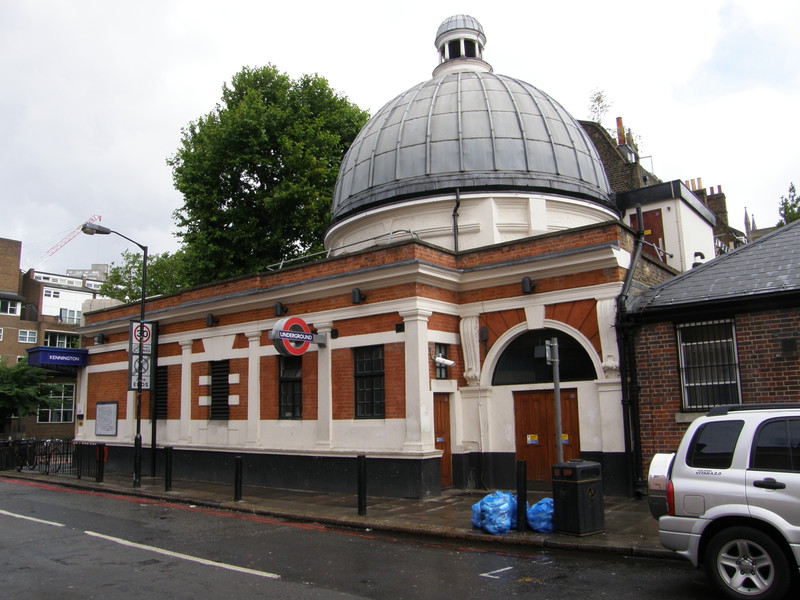
I'm genuinely surprised how long today's walk took. Given the mileage, it should have been a bit shorter than yesterday's longer haul through south London, but instead it took over an hour more. The reason? Almost all of the loop from Kennington to Euston and back is through heavily built-up areas, and they're so much slower to walk through.
One of the differences is that there is so much more to see, and it highlights a problem with my whole tubewalking escapade: I can only hope to capture the vaguest flavour of what it's like to walk through London. Out in the rural zones of the Metropolitan line it's much easier on both the foot and the camera, but when I'm walking though the centre of town, I can't let a photograph pass me by, and all the stopping and starting takes its toll on my walking time.
Still, that hardly matters, it just means I have to find the time to write up my city exploits from somewhere else, as it's normally too late to do anything when I get in except have a cup of tea and a piece of cake. It's a hard life, being a tubewalker...
Kennington to Elephant & Castle
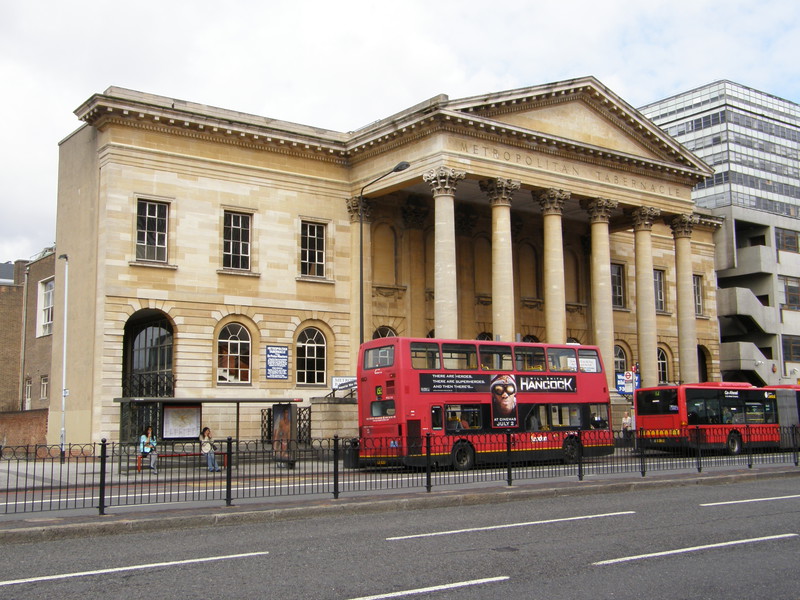
From Kennington station it's a short wander along the busy A3 to the Elephant and Castle Shopping Centre, past some rather faded buildings that look as if they're suffering from the effects of sitting in exhaust fumes for too long. The shopping centre is not much better, being voted in 2005 by readers of Time Out as London's ugliest structure, but there is a £1.5 million regeneration project afoot for the whole of the area that plans to restore Elephant and Castle to the major south London hub it once was, rather than the depressing concrete jungle it's become. These plans include the demolition of the shopping centre in 2010, as well as the redevelopment of social housing in the area that is deemed to have failed.
Hopefully the area will then be more sympathetic to the impressive 1861 Metropolitan Tabernacle opposite, a massive church that looks completely out of place opposite the dull mess of the shopping centre. The only other thing of note among the busy traffic is the Michael Faraday Memorial in the middle of the roundabout, which is effectively an impressively large metal box with very little to suggest what it is; it actually contains a transformer for the Northern line, appropriately enough given that Faraday was such an important figure in the science of electricity.

Elephant & Castle station is in two parts. The Northern line station – which was originally opened in 1890 as part of the City & South London Railway, the first deep-level Tube line, which we now know as the Bank branch of the Northern line – is in the northwest corner of the shopping centre, and is all shiny metal with sleek, modern lines, having been rebuilt first in the 1960s and again in 2003; the Bakerloo station, which dates from 1906, is on the northern side of the roundabout, and shows off the classic design principles of the Tube architect Leslie Green, who was responsible for designing the stations on the original sections of what are now the Northern, Bakerloo and Piccadilly lines. His characteristic designs were mostly two storeys high, with large semi-circular windows at the first floor level, and a distinctive cladding of ox-blood red glazed terracotta tiles (like the defunct Piccadilly station I came across at South Kensington). I'll be coming across a lot more Leslie Green stations on the next few lines, as my chronological walk through the Tube reaches the early 20th century.
Elephant & Castle to Borough
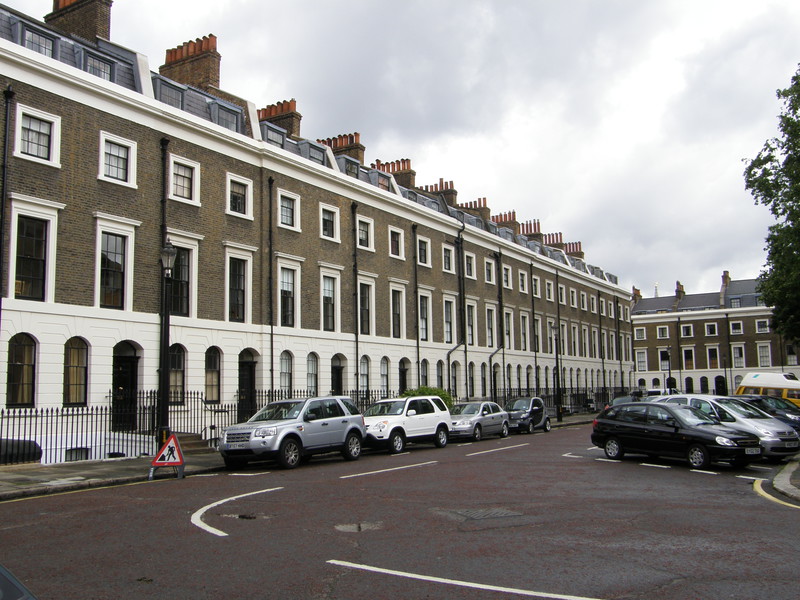
From the chaos of the main roundabout, it's a relief to dive into the quieter streets to the northeast, though it is still very urban (the park I walked through to the east of Avonmouth Street was more concrete than grass, and perhaps could do with cheering up a bit). However, Trinity Church Square is well worth a visit, with its Georgian terraces, dating from between 1824 and 1832, surrounding the bulk of Trinity Church, which is now called the Henry Wood Hall and is used for orchestral rehearsals. The garden is only open to residents, and contains one of the oldest statues in London, possibly of Alfred the Great, though you can't see a lot from the plebian side of the fence.
Borough station is back in the traffic on the A3, and although it was originally opened in 1890 as part of the City & South London Railway, it has recently been completely restored, as it had fallen into a rather sad state of disrepair. This is the northernmost station that still exists that was part of the original line; the original City & South London Railway ran from Stockwell to Oval, Kennington, Elephant & Castle, Borough and King William Street, which was just south of the present Monument station. King William Street was closed in 1900 when the line was extended north to Moorgate via London Bridge.
Borough to London Bridge
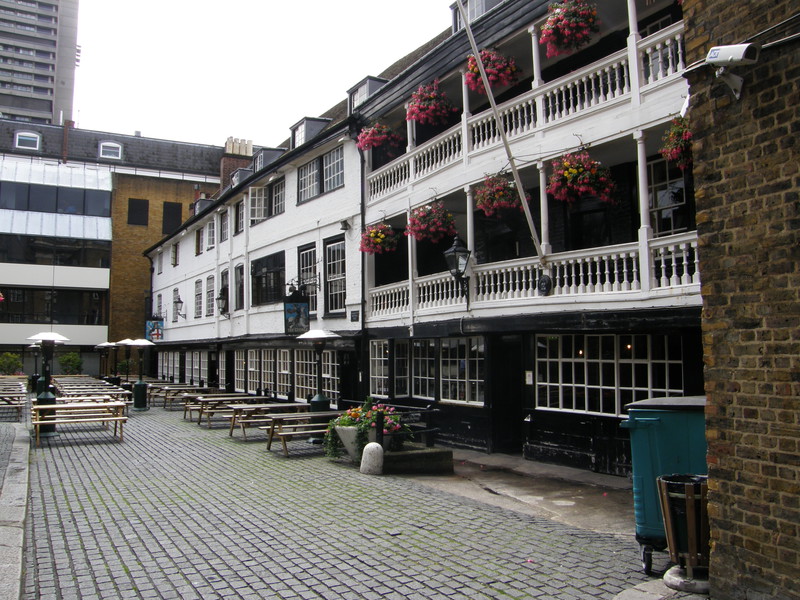
Being part of the main road from the south of England into the City, Borough High Street makes for a busy walking companion, but there is respite to be found. The George Inn, just off the main road on the right, is London's only surviving galleried coaching inn. The current inn, which lives on its own large cobbled courtyard back from the noise of the traffic, dates from 1676, when it was rebuilt after a fire swept through Southwark, though originally all three sides of the courtyard would have been galleried, rather than just the one side that survives (the Great Northern Railway used the George as a depot and pulled down two of its galleries to build warehouses, leaving just the south face). It was too early for a beer as I walked past, which is a shame, as it's an amazing pub.
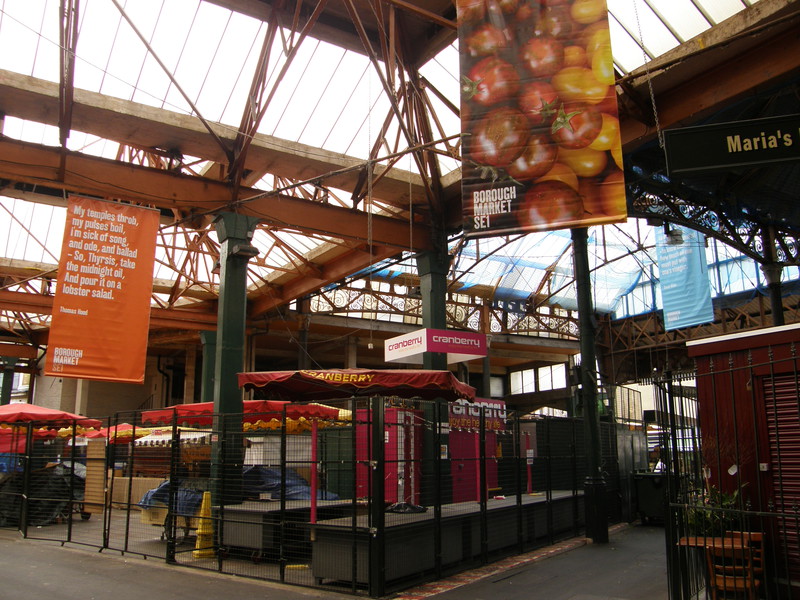
On the other side of the main road is Borough Market, one of London's most famous markets. You have to catch it when it's open to see it in its full glory – the retail market is only open on Thursdays, Fridays and Saturdays, though the wholesale market is open weekday mornings from 2am to 8am – but walking through it when it's shut is still an atmospheric experience. There has been a market here since Roman times, though the current buildings date from 1851, with various additions since (such as the 1932 Art Deco entrance on Borough High Street). Keep an eye open for Southwark Cathedral peeping over the buildings as you wander underneath the railway arches; I'll be back to explore this area further on my Jubilee line walk from Green Park to Canada Water.
London Bridge station is massive, and the Tube station is well hidden beneath the national rail station. The Tube first opened here on , as part of the City & South London Railway's extension from Borough to Bank and Moorgate. There are entrances on Tooley Street, Borough High Street and in the middle of the railway station; it's a very big station.
London Bridge to Bank
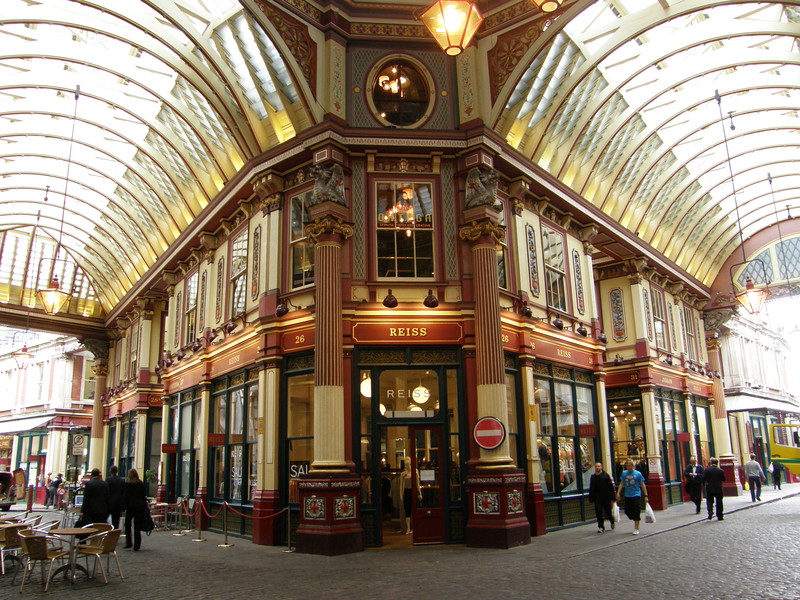
The architecture around London Bridge is not among the prettiest in the capital, so it's a relief to cross over London Bridge, with its great views east towards Tower Bridge. A bridge has existed on or near the existing London Bridge since Roman times, and it was the only bridge over the Thames below Kingston until Westminster Bridge was opened in 1750. It's easy to see what an important bridge this is, even though these days it's a fairly functional concrete structure that was built between 1962 and 1972, and looks it.
On the way to Bank, I decided to swing via the site of 20 Fenchurch Street, where they're building a new skyscraper. Nicknamed the Walkie-Talkie Tower and due to be completed in 2011, it will have a large viewing deck and sky gardens on the top floor, which will be open to the public. That should be something to behold, as will its design, which has a distinctive 'top-heavy' form.
Just before the Lloyd's Building, make sure you turn left into Leadenhall Market so you can join people like me, standing there and staring at the amazingly ornate roof. Painted in maroon, green and cream, the roof is amazingly ornate, and is quite breathtaking; it was designed in 1881 by Sir Horace Jones, who also designed Billingsgate and Smithfield Markets, and there has been a market here since the 14th century.
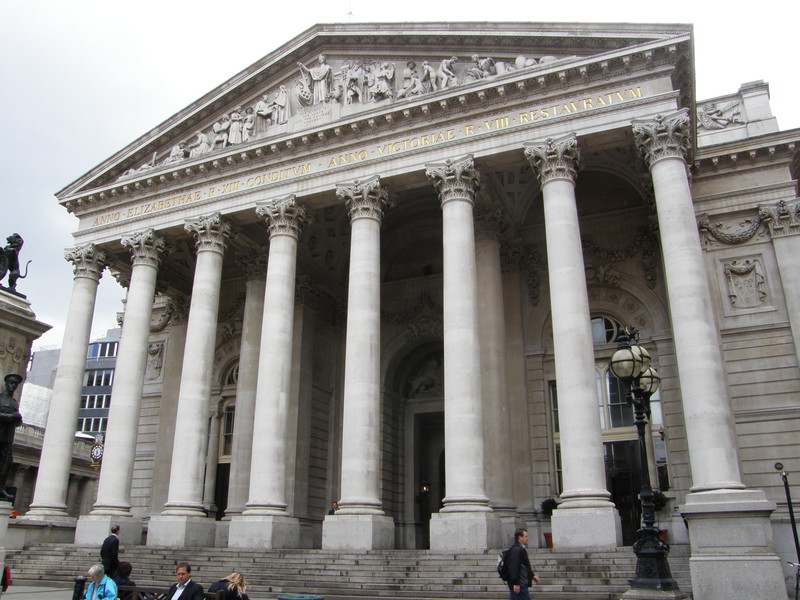
Heading west along Cornhill, don't miss the Gothic porch into St Michael's Church, tucked away just off the street. The church itself is a Wren design dating from 1670 to 1677, but the porch on Cornhill is a later addition from 1858-1860. Further along the road, it's hard not to be cowed by the impressive architecture of the Royal Exchange and the Bank of England. The former building is now a shopping centre, albeit a particularly impressive one that dates from 1844, but the Bank of England is still very much in business, as it has been since 1734.
Bank station is completely subterranean, the only signs of the station being the numerous subways dotted around the road junction.
Bank to Moorgate
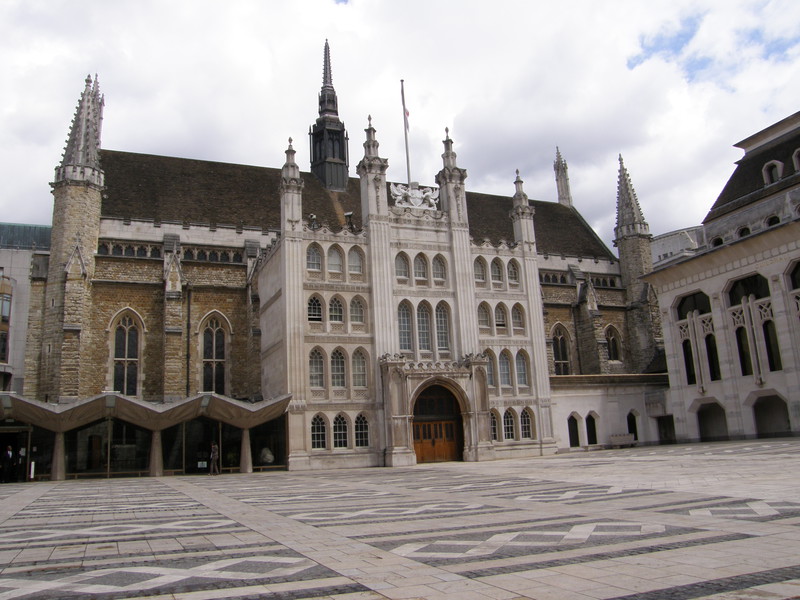
Heading northwest from Bank, there are some lovely thin streets of a type that I just love stumbling upon; my favourite is the relatively plain Ironmonger Lane, as it's not wide enough to carry a bus, and curves at just the right angle to enhance the feeling of being hemmed in by city buildings. It makes it a bit of a shock to burst out into the wide open courtyard of the Guildhall, which makes a great spot for contemplation and maybe a bit of lunch. The Guildhall is the ceremonial and administrative centre of the City of London and the Corporation of London, so it's effectively the town hall for the City. The current building along the northern side of the courtyard is impressive, and parts of it date from 1441; it was the only stone building not belonging to the Church that survived the Great Fire of London in 1666, though there have been plenty of additions since, such as the rather grand entrance, which was added in 1788. St Lawrence Jewry Church on the southern side of the square was rebuilt by Christopher Wren after being destroyed in the fire, but it was burned down again during the Blitz, after which it was rebuilt yet again in a similar style to the Wren church.
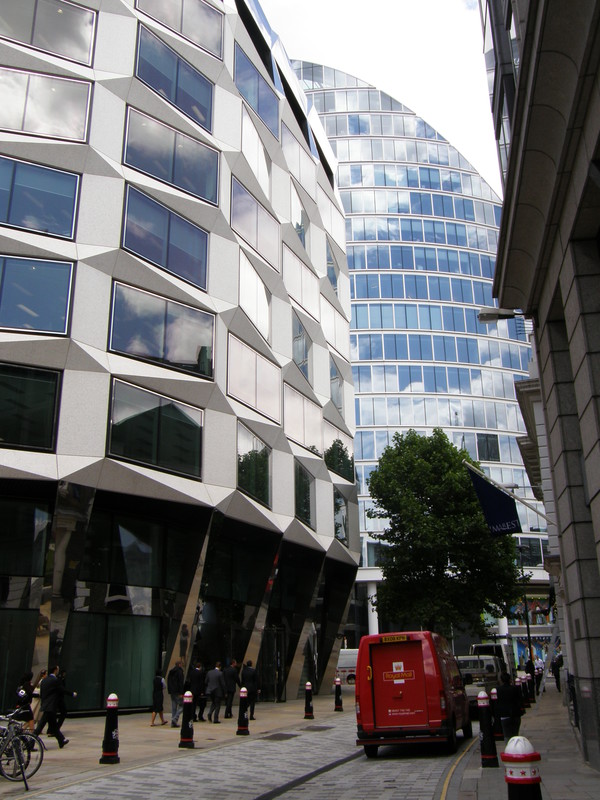
Turning from the old to the new, the buildings to the north of the Guildhall along Basinghall Avenue are stunning. We all know about the buildings that break the skyline – the Gherkin, Canary Wharf and so on – but there are plenty of amazing creations that you can only see if you visit them yourself, and the amount of glinting glass and gracious curves along Basinghall Avenue and Coleman Street is impressive. On the other side of London Wall lies the amazing Moorhouse Building, built in 2004. This building has the deepest foundations in London, going down to a depth of 57m, and it's also the first building to be designed specifically with Crossrail in mind, as it has a shaft down to the station under the building. Its curves are very gracious, but that's not surprising, as the architect was Sir Norman Foster, the designer of the Gherkin.
Moorgate station is on the left, just past the Moorhouse Building, the entrance dating from the 1900 extension to the City & South London Railway, when it was opened as Moorgate Street.
Moorgate to Old Street
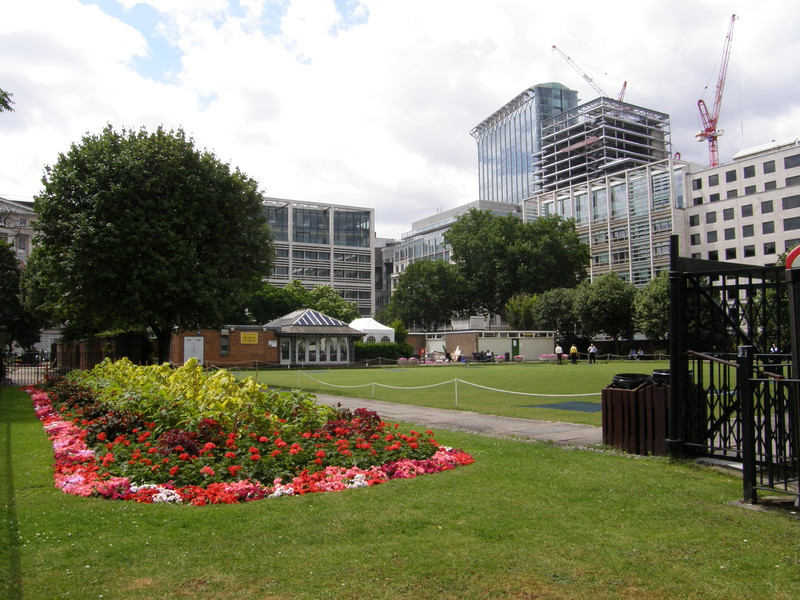
Heading north from Moorgate, the first point of interest is Finsbury Square, which is either a lovely square or a bit of an architectural disaster, depending on which angle you look at it from. In the middle of the square is a lovely bowling green with some very pretty flower beds, and as the square is large and surrounded by some grand buildings, this makes for some great 'city square' views. However, the southern end of the square is full of rather ugly pre-fab buildings that make it look like a failed experiment in cheap urban development, and this is a great shame, as otherwise it's an impressive place.
Back on City Road, it's worth popping into the Bunhill Fields Cemetery, though the graves are fenced off from the public, so you'll have to do your grave-spotting from a distance. Used as a burial site for non-conformists from the late 17th century to the middle of the 19th century, notable residents include William Blake, John Bunyan and Daniel Defoe. On the other side of the road is the fine Georgian building of Wesley's Chapel, which was built by John Wesley, the founder of the Methodists, in 1778. Wesley lived in the house next door for the last 11 years of his life, where he died on . He is buried in the garden to the rear of the chapel, along with six of his preachers, his sister Martha Hall, and his doctor and biographer, Dr John Whitehead.
Old Street station is north along City Road, and is completely hidden beneath the large roundabout where City Road meets Old Street. Originally opened in 1901 as part of the City & South London's extension from Moorgate to Angel, the only signs of the station from above ground are the signed staircases down to the shopping arcade and station below the hectic roundabout.
Old Street to Angel
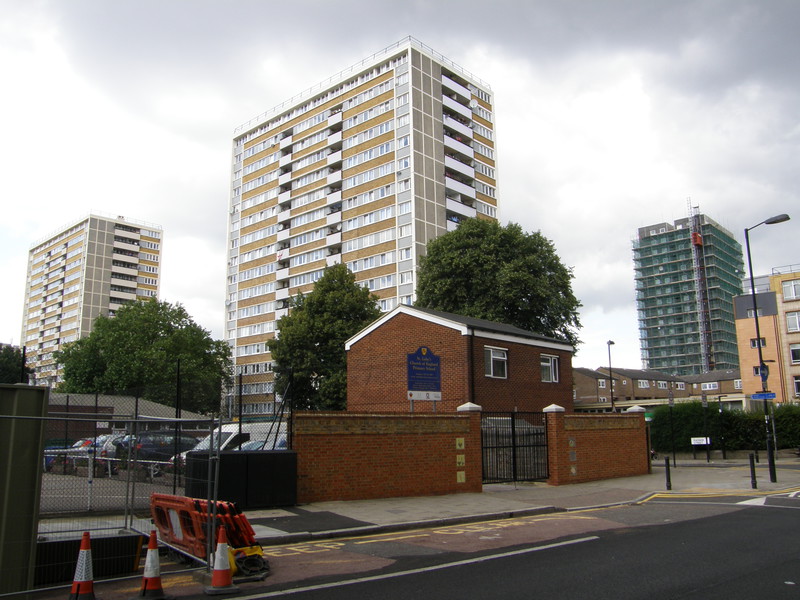
I worked in Old Street for three weeks a couple of years ago, and as a place to work, it's not great. Old Street itself is busy and doesn't have a terribly wonderful selection of shops or eateries, and I couldn't wait to get out of there and onto another contract; I therefore didn't waste much time heading north from the main road and into the estates that dominate this area. The estates aren't at all ugly, and there's evidence of redevelopment work of gardens and play areas along Radnor Street, which is good to see after the sorry state of some of the inner-city estates I've visited.
The estates suddenly change into much more desirable residences as you cross City Road, past an incredibly ugly building that turns out to be the lift shaft from the old City Road station. This station was opened in 1901 as part of the extension to Angel, but closed again in 1922 due to low numbers of passengers.
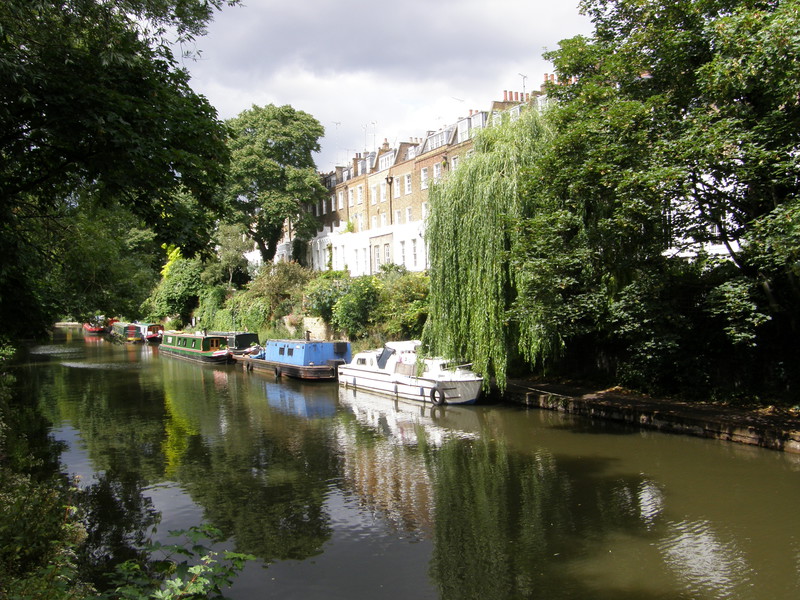
It's in Graham Street that the atmosphere turns from the gritty reality of urban housing estates into the rather more exclusive residences of Islington. City Road Basin is the site of some impressive residential development, and you can visit the basin via the Graham Street Park at the northern end of the road. Even more enjoyable is the short stretch of the Regent's Canal to the north of Vincent Terrace, where the towpath is open to the public. It's a peaceful experience, gazing at the backs of the houses on Noel Street with the pretty narrow boats moored just below, but it's short-lived, as the canal soon disappears into the 886m-long Islington Tunnel.
Islington High Street is a short walk along some beautiful streets lined with lovely Georgian-style terraces, and Angel station is a little further to the north. Angel was originally opened by the City & South London Railway in 1901 as the northern terminus of the extension from Moorgate, and it's now famous for having the longest escalators in western Europe. These were added in a major revamp of the station in 1992, which aimed to cut congestion and overcrowding by removing the island platform and replacing the small capacity Otis lifts with escalators. The exterior of the station was rebuilt at the same time, so there are no terracotta tiles here.
Angel to King's Cross St Pancras
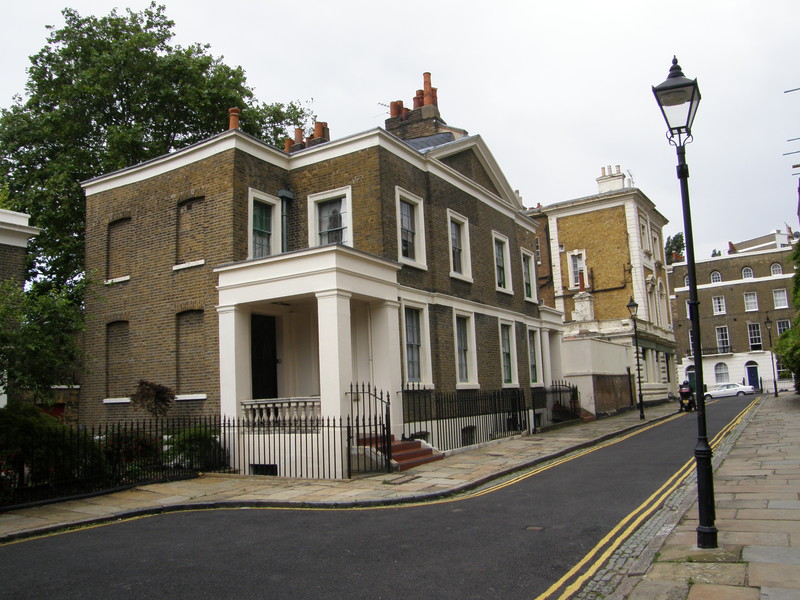
From Angel to King's Cross, the walking is delightful. This is expensive territory, and Myddelton Square and Lloyd Square are wonderful. The former was built between 1826-1828, with the church of St Mark the Evangelist in the middle being added in 1827 at a cost of £16,000; the Georgian terraces surrounding the central green are great. Lloyd Square is even more impressive, the surrounding houses dating from 1820-1830, each of them sporting a distinctive pediment instead of a third storey (thankfully without supporting columns, which would perhaps be too much). There's a private garden in the middle of the square, with great views down the hill towards the BT Tower.
Percy Circus can be reached along some interesting backstreets (bizarrely, for this area, there's also a boarded-up old pub, the Percy Arms, that could do with some attention, but I guess that goes to show that pubs are having a hard time throughout the whole country, even in the poshest areas). According to a blue plaque, Vladimir Ilyich Ulyanov Lenin, founder of the USSR, stayed at 16 Percy Circus in 1905. The Circus itself looks a little worn (though in a charming way), with one corner sporting a modern and fairly uninspiring bit of social housing; that's probably because we're nearly in King's Cross, and King's Cross is a much more earthy part of London than Islington.
King's Cross St Pancras station can be found along some interesting backstreets, where old warehouses are being converted into pleasant office and residential blocks. King's Cross is the Next Big Thing, now that the terminus for the Eurostar has opened its doors in St Pancras, and you can see its potential. The station itself is a massive affair, being the largest interchange on the Tube network, with six lines on four pairs of tracks. The main entrance is on the north side of the road, but there's a subway entrance on the south side too.
King's Cross St Pancras to Euston
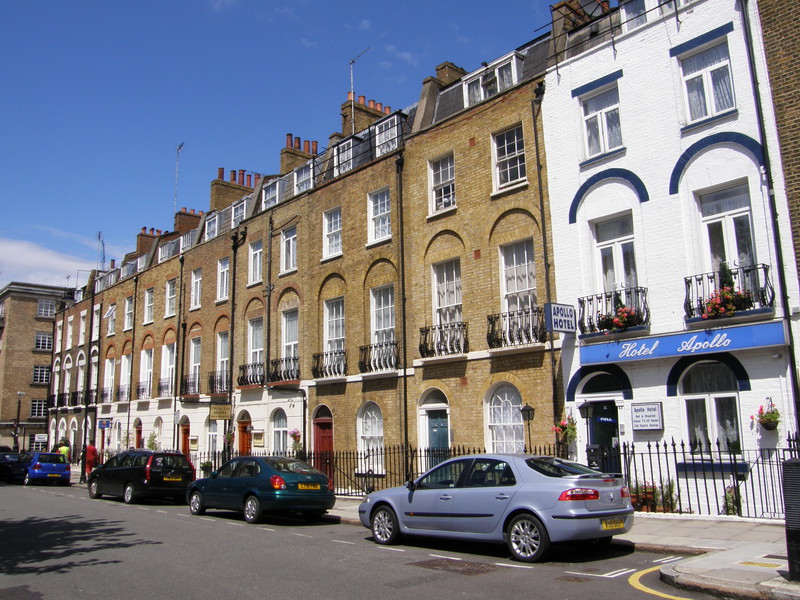
From the station, I decided to wander through the backstreets to the south of the busy Euston Road, and it's a surprisingly enjoyable part of town. I say 'surprisingly' because I've never heard anyone associate King's Cross with good walking, but I came across a nice little pub and a number of quaint terraces well away from the noise of the main road. OK, so there are quite a few monstrous buildings that don't exude a lot of charm – for example, the UNISON Headquarters is huge and not the prettiest monolith in the world – but I enjoyed my wander towards Euston.
Euston station is another massive affair, with the Tube station buried deep beneath the mainline station. This is where the Bank and Charing Cross branches of the Northern line meet; I'll be walking north from Euston tomorrow, but today's walk is a loop up the Bank branch and down the Charing Cross branch, so from here I turned south on the long walk back to Kennington.
Euston to Warren Street
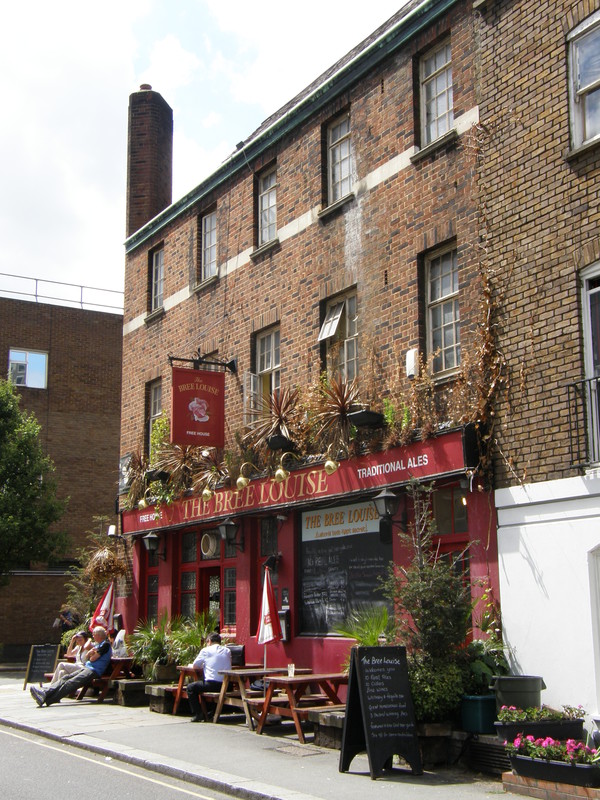
It isn't far from Euston to Warren Street, and by far the best way to walk it is via Euston Street, and in particular the Bree Louise, one of those pubs you wish you'd known about for a lot longer. It serves a massive range of great real ales, but just as importantly, it also serves exquisite pies with a good range of fillings, rounded off with mash, veg and gravy. If you're passing through here at the right time of day, stop for lunch; failing that, stop for a pint. It's great, and Euston Street is quiet enough to feel away from it all, just for a while.
The chaos of Euston Road kicks in again on the approach to Warren Street station, which opened on as part of the original Charing Cross, Euston & Hampstead Railway. This deep-level Tube line served 16 stations on opening, from Charing Cross up to Camden Town, where it forked to serve Golders Green and Archway; we now know it as the Charing Cross branch of the Northern line, after extensions took it from Golders Green to Edgware, and from Charing Cross down to Kennington. Warren Street was originally called Euston Road, but it changed its name the following year. The current station building is not the original, which was designed by Green in the same ox-blood red style that he used for the City & South London Railway stations; this was replaced by the current Portland stone building when escalators were installed in the early 1930s.
Warren Street to Goodge Street
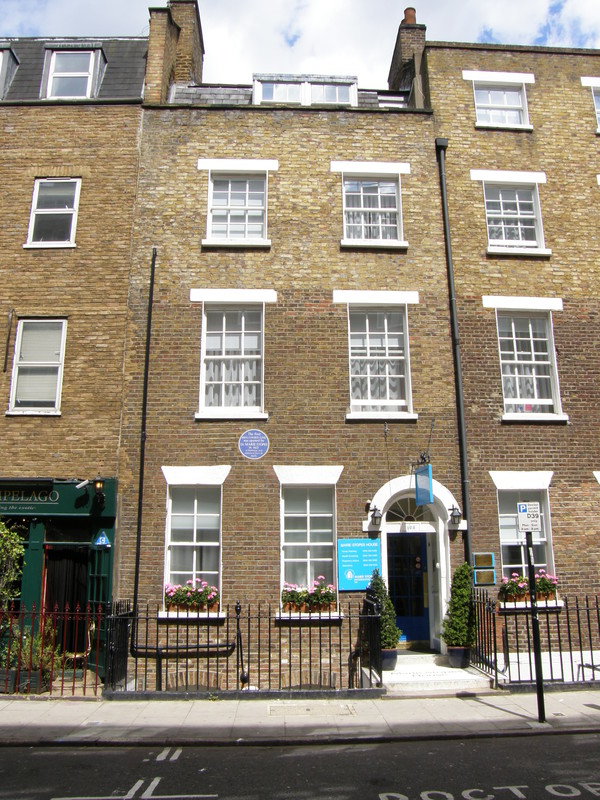
The most direct route to Goodge Street is along Tottenham Court Road, but this is a seriously busy shopping street, and it's much more enjoyable to walk along the parallel Whitfield Street. Sporting a number of pleasant pubs and restaurants, it's also home to the Marie Stopes Clinic. Back on , Marie Stopes opened the UK's first family planning clinic in Holloway in north London, which offered a free service to married women and gathered scientific data about contraception. In 1925, the clinic moved to Whitfield Street, where it still operates today, having changed the way the world thinks about birth control.
Further down the road and behind Goodge Street station is Pollock's Toy Museum, which houses an eclectic but fascinating collection of toys from around the world. It's run by the grandson of the founder and is well worth a look.
Goodge Street still sports its original Leslie Green design, complete with the characteristic ox-blood red tiles. This is a good example of how Green's designs were built with a flat roof, to enable further buildings to be placed on top. Deep under Goodge Street station is one of the eight deep-level air-raid shelters along the Tube, but this one is particularly important, for it was from here on that General Eisenhower, the Supreme Commander of the Allied forces in Europe, announced the invasion of France.
Goodge Street to Tottenham Court Road
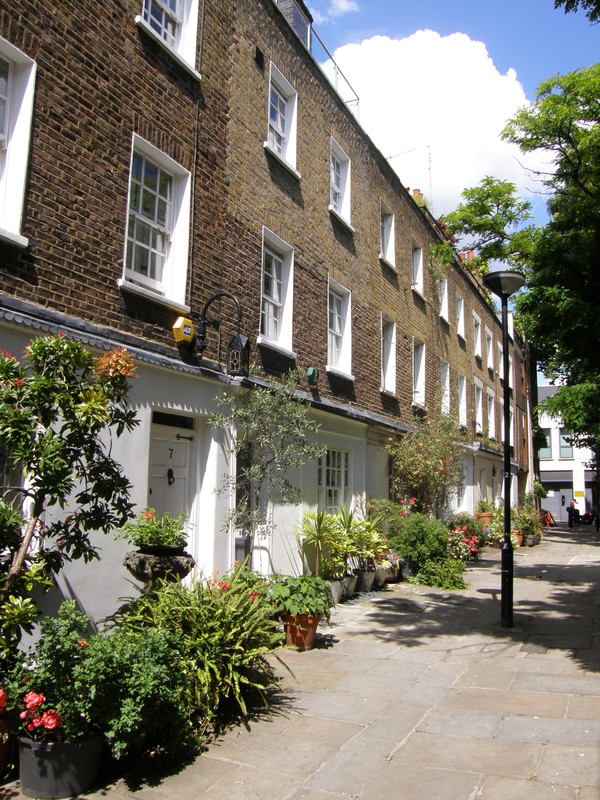
Just to the south of the Tube station is a lovely little mews on a small square, Colville Place, which is well worth a visit; I dare not even speculate how much one of these charming townhouses might cost, but it's fun to walk through. Charlotte Street is just along the end of the mews, and if I was to do this walk again I'd probably just walk down Charlotte Street to Oxford Street, but for a reason that I can't recall right now, I decided to design a route through a couple of pedestrian tunnels to Newham Street. This turned out to be a lot less interesting than Charlotte Street, though if you look right as you come into Newham Street, there's a good view of the BT Tower, and that's always a pleasure.
Oxford Street hardly needs an introduction: it's busy, touristy and chaotic, but it's always fun to walk along. Tottenham Court Road station is on the corner with – you guessed it – Tottenham Court Road, in a really grimy building that heralds a new design on my tubewalk, as the station was originally opened on as part of the Central London Railway, now the Central Line. In common with the other stations on the original line, the station was designed by Harry Bell Measures, though the station has been considerably modified in the meantime. The Northern line, in the guise of the Charing Cross, Euston & Hampstead Railway, came through here on , using Oxford Street as its station name, but an interchange was built in 1908, when both stations were named Tottenham Court Road
Tottenham Court Road to Leicester Square
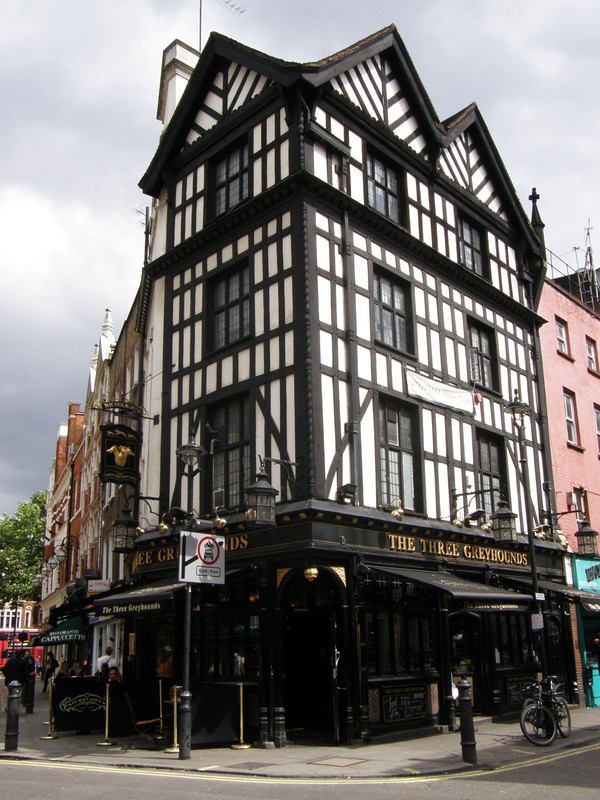
Leaving Tottenham Court Road, the most obvious building is the towering Centrepoint, which dominates the junction with Oxford Street. In contrast, Soho Square is relatively quiet, with its central garden that's popular with lunching employees and tramps alike. Head down Greek Street, and you come to Soho, the traditional home of everything that is sleazy about London, though these days it's pretty tame, and instead of prostitution, it's the gay capital of London and a major tourist attraction.
Old Compton Street is a fun place to wander down, with its theatres, restaurants and gay bars, and just over Shaftesbury Avenue is Gerrard Street, home to the Chinese community in London. Until the 1970s this was just another run-down part of sleazy Soho, but gradually Chinese restaurants and shops started to take over the area, and it's now regarded as London's Chinatown, complete with decorated Chinese arches at the entrances to the street. Ronnie Scott's Jazz Club originally opened in the basement of number 39, though it moved to Frith Street in 1965, where it's still going strong.
The main entrance to Leicester Square station is back on Charing Cross Road, its Portland stone façade dating from a station revamp in the early 1930s. However, a smaller entrance on the opposite side of the road is still decked out in the red terracotta tiles of the original 1906 Charing Cross, Euston & Hampstead Railway station.
Leicester Square to Charing Cross
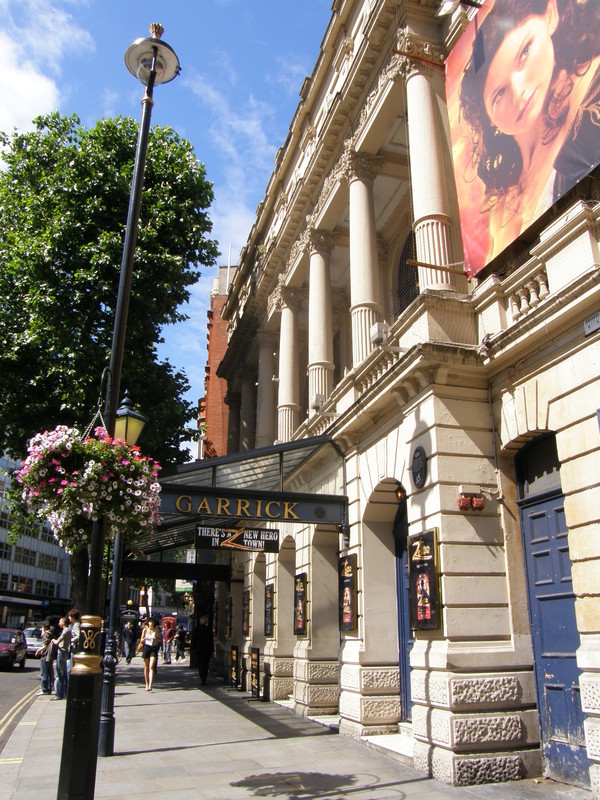
The twin themes of Charing Cross Road, south of the Tube station, are books and theatre, with Wyndham's Theatre and the Garrick Theatre rubbing shoulders along the eastern side of the road. Further down, opposite the blocky statue of Edith Cavell – the British nurse in World War I who helped hundreds of Allied soldiers escape from German-occupied Belgium – is the National Gallery, and then the view opens up on Trafalgar Square, with Nelson's Column dominating the scene. I'll be visiting Trafalgar Square properly on my Piccadilly line tubewalk from Hammersmith to King's Cross St Pancras, so today I only brushed the northeast corner.
Outside Charing Cross station sits Eleanor's Cross, though it's currently wrapped up in a huge tower of scaffolding and blue sheeting, hiding any signs of the monument inside. This cross is an 1865 replacement of the original Eleanor Cross that stood on the south side of Trafalgar Square, and the cross is regarded as the official centre of London as far as legislation and measuring distances from London are concerned.

Charing Cross station used to be two separate Tube stations: the Baker Street & Waterloo Railway (now the Bakerloo line) opened a station here on and called it Trafalgar Square, while the Charing Cross, Euston & Hampstead Railway (now the Charing Cross branch of the Northern line) opened another one called Charing Cross on , which at the time was the southern terminus of the new line. The two stations, after various name changes, were combined into the current Charing Cross station when the Jubilee line was built in 1979; originally Charing Cross was the southern terminus of the Jubilee line, but when the line was extended in 1999, the Jubilee line was diverted via Westminster and Waterloo, and the Jubilee platforms at Charing Cross were closed. They're now used for filming.
Charing Cross to Embankment
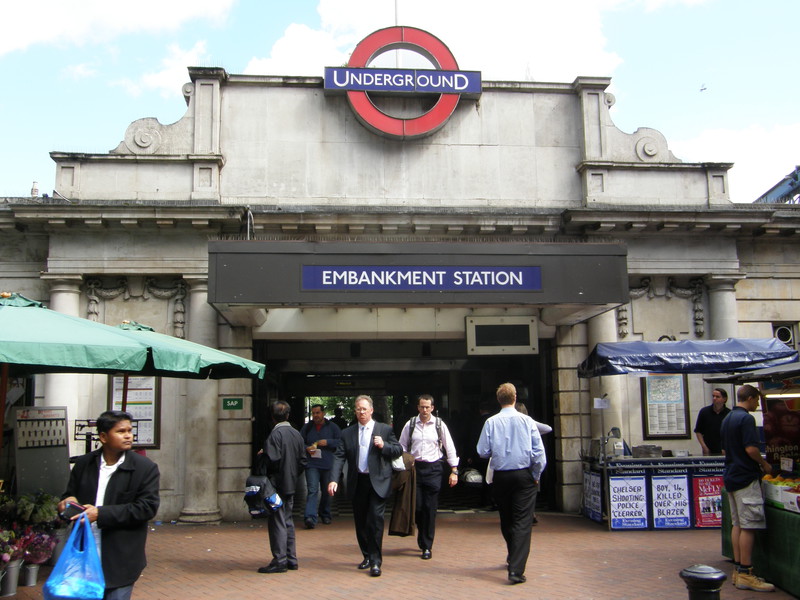
It's a tiny walk from Charing Cross to Embankment, down Villiers Street and past the entrance to Victoria Embankment Gardens, which I visited when walking the District line from Victoria to Bow Road. Villiers Street is lined with pubs, restaurants and shops, with yet more shops in the shopping centre in the main Charing Cross building on the right, though at busy times the crowd has to be seen to be believed. In the arches to the right as you walk down the hill you can find the famous Heaven nightclub, which has been entertaining the gay community in flamboyant style since 1979.
Embankment station is at the bottom end of the street, and luckily you can walk straight through the station foyer to Victoria Embankment without needing a ticket.
Embankment to Waterloo
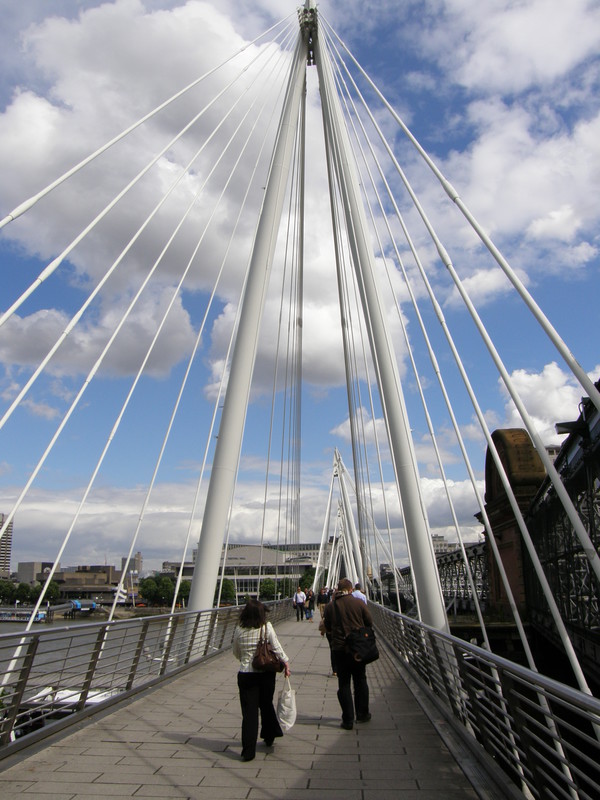
Just outside the station exit are the steps up to Hungerford Bridge, though you do have a choice of which side of the bridge you walk along. If you want the traditional view of the City, as immortalised in the Kinks' song 'Waterloo Sunset', then you should take the first set of steps, but if you want a view of the Houses of Parliament and the London Eye, go under the bridge and take the steps on the other side. Whichever choice you make, you won't be disappointed, as this is one of the best river views of them all.
Jubilee Gardens is on the other side of the river, dominated by the huge London Eye and the tall, Portland stone-clad skyscraper of the Shell Centre on the eastern side of the grassy area. This is a great place for people watching, with mime artists entertaining the tourists along the walkway, while others stare up at the frankly astounding bulk of the Eye.
Waterloo station is just along York Road to the left, and the easiest way to get to the Tube is up the steps outside the Shell Centre, which take you into the main hall of the railway station, where there's an entrance to the Tube. Alternatively, you can keep going along the road and turn right to see the impressive main entrance to the station, and follow the steps up to reach the same spot. The extension from Charing Cross to Kennington was opened via Waterloo in 1926, after the City & South London Railway and the Charing Cross, Euston & Hampstead Railway were amalgamated into the Underground Electric Railways Company of London Limited, the forerunner of today's London Underground. However, the first Tube station at Waterloo was opened on the Waterloo & City line on , followed by the Bakerloo on , so the Northern line was a bit of a latecomer to the party.
Waterloo to Kennington
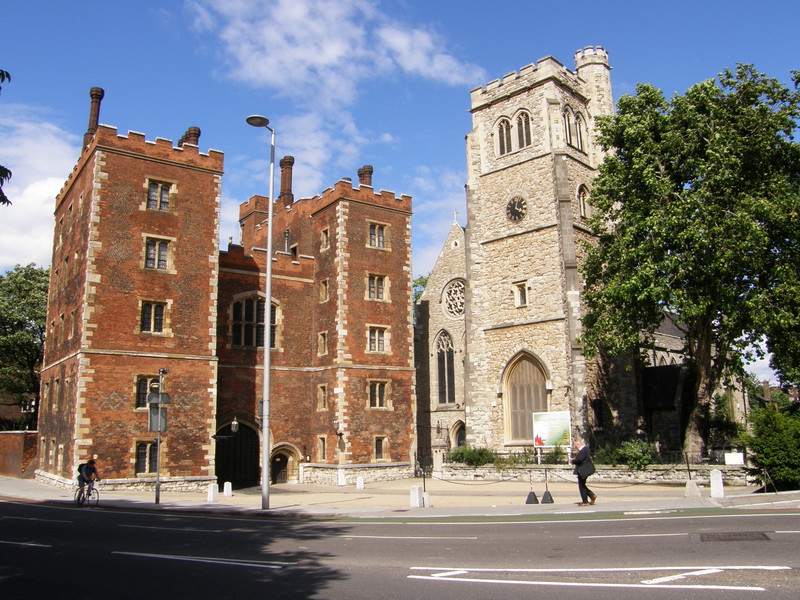
It's a rather boring walk along York Road and Lambeth Palace Road from Waterloo to the eastern end of Lambeth Bridge, but it's worth the effort to see Lambeth Palace, the official London residence of the Archbishop of Canterbury. The red brick gatehouse dates from 1440, though nearby St Mary-at-Lambeth Church is somewhat more modern, having been rebuilt around 1850.
Just as imposing are the apartments of Parliament View, on the other side of the road junction from Lambeth Palace. The 183 apartments and seven penthouses have great views of the Houses of Parliament, and the curved glass design is rather attractive. A three-bedroom apartment here currently sells for about £850,000; it's not hard to see why.
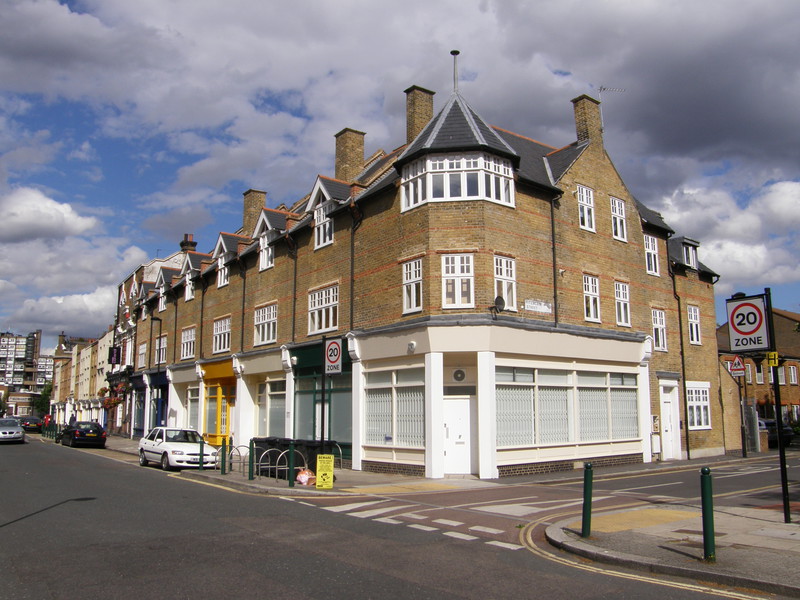
Things suddenly get a lot earthier as you step into the backstreets behind Parliament View. This area was bombed in the Blitz and subsequently got rather run-down, but before this fate, Lambeth Walk was notable for its street market and working class culture, so much so that the song 'The Lambeth Walk' from the 1937 musical Me and My Girl was named after the street. These days it's home to a few apartment blocks and is a quiet and pleasant little spot, though it does smell of burned coffee beans, as Costa Coffee's roasting works is next to the railway line on Old Paradise Street, and it's pretty fragrant.
Between here and Kennington Road is a large estate, with tower blocks overlooking the enjoyable green space of Lambeth Walk Doorstep Green. The high-rises aren't the most attractive on the planet, but there is plenty of lovely housing over the Kennington Lane, in Chester Way and along Cottington Street. And there, a little walk south along Kennington Road, is Kennington station, back where we started this morning. It's a long walk, this, but it takes in such a huge swathe of central London that it has to be one of the more interesting tubewalks you can do. Just make sure you leave plenty of time for photography...